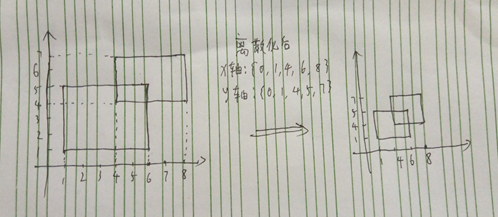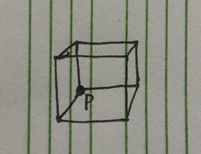题意: 某雕塑由 n (n<=50) 个边平行于坐标轴的长方体组成。每个长方体用 6 个整数 x0, y0, z0, x, y, z 表示(1<= x0, y0, z0, x, y, z <= 500)。 x0 为长方体顶点中,x 坐标的最小值,x 表示长方体在 x 方向的长度。其他 4 个值类似定义。统计这个雕像的体积和表面积。注意,雕像内部可能会有密闭的空间,其体积应该算在总体积中。
例样输入:
2
2
1 2 3 3 4 5
6 2 3 3 4 5
7
1 1 1 5 5 1
1 1 10 5 5 1
1 1 2 1 4 8
2 1 2 4 1 8
5 2 2 1 4 8
1 5 2 4 1 8
3 3 4 1 1 1
例样输出:
188 120
250 250
解题思路:由于雕塑内部存在密闭空间,不能直接用 bfs 计算雕塑体积。在雕塑周围围上上一圈空气,用广搜遍历空气,体积 = 总体积 - 空气体积,表面积 = 空气与雕塑的接触面积。
注意点:
1、 根据输入数据,需要建立 1000 * 1000 * 1000 的三维坐标系,数据量为 10^9 ,会超内存,因此采用离散化数据的方式。50个长方体最多可能有100 个不同的坐标,因此建立的坐标系为 100 * 100 * 100 的坐标系,数据量为 10^6。
离散化: 只关心要用的数据,将大量的或无穷的数据转化成有限个数据,将连续的数据转化成有限个区间,每个区间只存在一种状态。 例如:

2、 用一个点表示一个长方体。

AC代码:
/* Sculpture (UVa12171) */ #include <iostream> #include <cstring> #include <algorithm> #include <queue> using namespace std; const int maxn = 105; const int maxr = 1005; int dx[] = {1,-1, 0, 0, 0, 0}; int dy[] = {0, 0, 1,-1, 0, 0}; int dz[] = {0, 0, 0, 0, 1,-1}; struct Point{ int x, y, z; Point(int x, int y, int z): x(x), y(y), z(z){} Point(){} }; Point p[maxn]; int x[maxn], y[maxn], z[maxn]; //离散化后的坐标轴 int a[maxn][maxn][maxn]; //离散坐标系 int vis[maxn][maxn][maxn]; //标记是否访问 int n, nx, ny, nz; //数据量以及离散坐标轴的长度 int v, s; void input(); //输入 void build(); //填格子 void bfs(); //广搜求 v 和 s int getArea(int tx, int ty, int tz, int dir); //计算 tx ty tz 长方体在 dir 方向上的面积(与空气的接触面积) int main(){ //freopen("input.txt", "r", stdin); int T; cin >> T; while(T--){ input(); build(); bfs(); cout << s << " " << v << endl; } } void input(){ memset(a, 0, sizeof(a)); memset(vis, 0, sizeof(vis)); v = 0; s = 0; cin >> n; for(int i=1; i<=2*n; i+=2){ cin >> p[i].x >> p[i].y >> p[i].z; cin >> p[i+1].x >> p[i+1].y >> p[i+1].z; p[i+1].x += p[i].x; p[i+1].y += p[i].y; p[i+1].z += p[i].z; //算出坐标 x[i] = p[i].x; y[i] = p[i].y; z[i] = p[i].z; x[i+1] = p[i+1].x; y[i+1] = p[i+1].y; z[i+1] = p[i+1].z; } x[0] = 0; y[0] = 0; z[0] = 0; //将坐标轴排序去重 sort(x, x+2*n+1); sort(y, y+2*n+1); sort(z, z+2*n+1); nx = unique(x, x+2*n+1) - x; ny = unique(y, y+2*n+1) - y; nz = unique(z, z+2*n+1) - z; //在周围围上空气 x[nx++] = maxr; y[ny++] = maxr; z[nz++] = maxr; } void build(){ for(int i=1; i<=2*n; i++){ int x1, x2, y1, y2, z1, z2; //长方体在离散化后的坐标系中的位置 x1 = lower_bound(x, x+nx, p[i].x) - x; x2 = lower_bound(x, x+nx, p[i+1].x) - x; y1 = lower_bound(y, y+ny, p[i].y) - y; y2 = lower_bound(y, y+ny, p[i+1].y) - y; z1 = lower_bound(z, z+nz, p[i].z) - z; z2 = lower_bound(z, z+nz, p[i+1].z) - z; for(int i=x1; i<x2; i++) //左闭右开区间填格子 for(int j=y1; j<y2; j++) for(int k=z1; k<z2; k++) a[i][j][k] = 1; } } void bfs(){ queue<Point> q; q.push(Point(0, 0, 0)); vis[0][0][0] = 1; while(!q.empty()){ Point t = q.front(); q.pop(); //如果这一点为空气,则累加空气体积 if(a[t.x][t.y][t.z] == 0) v += (x[t.x+1] - x[t.x]) * (y[t.y+1] - y[t.y]) * (z[t.z+1] - z[t.z]); for(int i=0; i<6; i++){ int tx, ty, tz; //与 t 点相邻的点 tx = t.x + dx[i]; ty = t.y + dy[i]; tz = t.z + dz[i]; if(tx<0 || tx>=nx-1 || ty<0 || ty>=ny-1 || tz<0 || tz>=nz-1) //过滤掉出界的情况 continue; if(a[tx][ty][tz] == 1){ //为长方体,则计算接触面积并累加 s += getArea(tx, ty, tz, i); }else if(a[tx][ty][tz] == 0 && vis[tx][ty][tz] == 0){ //为空气并且没访问过,则加入队列 q.push(Point(tx, ty, tz)); vis[tx][ty][tz] = 1; } } } v = maxr*maxr*maxr - v; } int getArea(int tx, int ty, int tz, int dir){ //不同方向的接触面,面积不同 if(dx[dir] != 0){ return (y[ty+1]-y[ty]) * (z[tz+1]-z[tz]); }else if(dy[dir] != 0){ return (x[tx+1]-x[tx]) * (z[tz+1]-z[tz]); }else{ return (x[tx+1]-x[tx]) * (y[ty+1]-y[ty]); } }